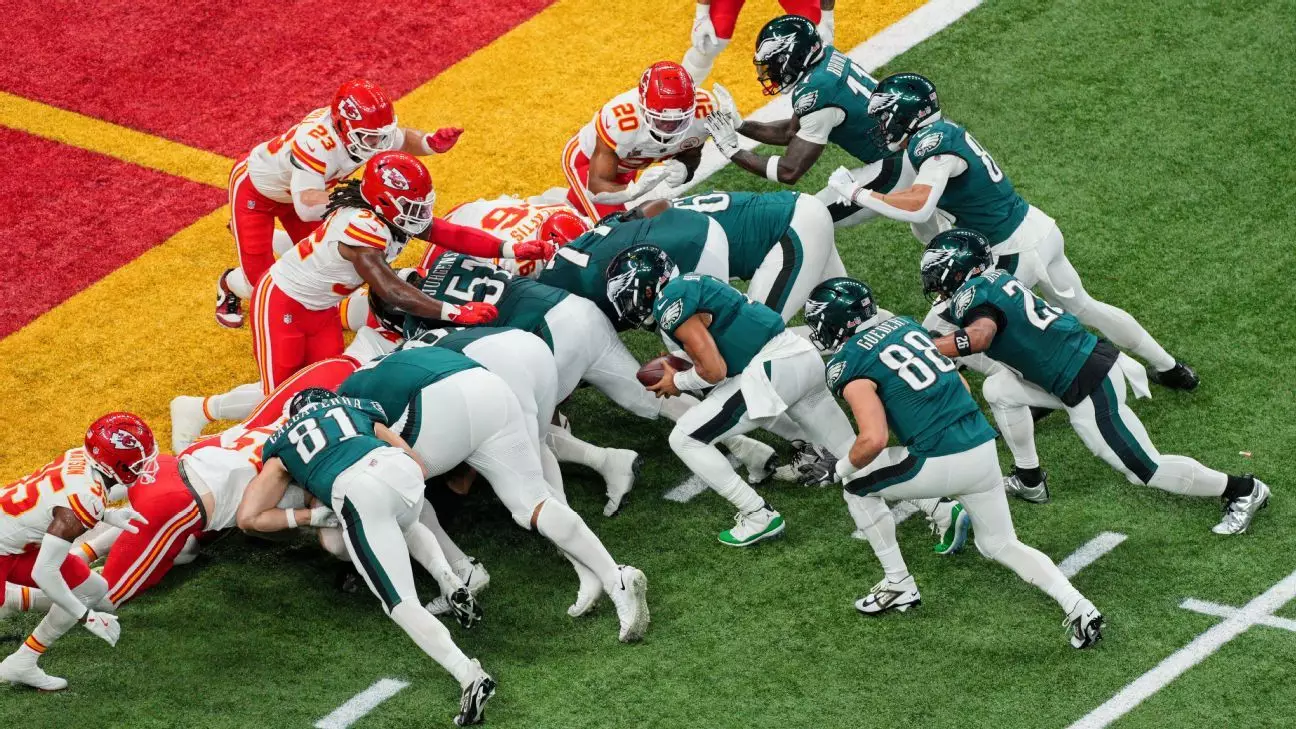In a surprising move that has stirred debates among fans and analysts alike, an NFL team has put forth a proposal to outlaw the controversial “tush push” quarterback sneak, as articulated by Troy Vincent, the NFL’s executive vice president of football operations. The exact identity of the team behind this initiative remains undisclosed, creating a sense of intrigue and speculation in the sports community. With discussions taking place during the NFL scouting combine, stakeholders will have an opportunity to weigh in on a strategy that could redefine certain aspects of the game.
As NFL owners prepare for a potential vote at their upcoming spring meeting in Palm Beach, Florida, the stakes are high. If the proposal is not withdrawn, it will require a significant majority—24 out of 32 owners—to secure approval. Each season, the NFL opens the floor to rule proposals from teams, alongside those mounted by the competition committee, making this a crucial inflection point for the future of a play that has gained notoriety for its effectiveness.
The “tush push” design involves quarterbacks aligning themselves with offensive players positioned to propel them forward through a wall of defenders. This tactic has recently gained popularity, particularly among teams like the Philadelphia Eagles and Buffalo Bills, who have executed a staggering 163 “tush pushes” in the last three seasons alone; that is more than all other NFL teams combined. This tactic boasts an astonishing success rate of 87% for touchdowns or first downs—far superior to the 71% average across the league, according to data from ESPN Research.
The technique isn’t just an offensive play; it’s a strategic pivot in football that leans heavily on physicality and team coordination. Jalen Hurts, quarterback for the Eagles, has publicly showcased the play’s potency, even using it to score in crucial moments such as Super Bowl LIX. The engagement surrounding this play highlights the critical intersection of innovation and traditionalism that frequently defines American football.
Despite the success of the “tush push”, Vincent has pointed out that the play has faced scrutiny before. While it has demonstrated a remarkable ability to yield results for a few select teams, there are concerns regarding its long-term viability and the safety implications associated with such intense physical collisions. The delicate dance between promoting challenging play and ensuring player safety has never been more pronounced.
The narrative further complicates when examining player reactions, particularly after incidents like those involving Washington Commanders linebacker Frankie Luvu, who faced penalties for attempting to jump the line against the Eagles’ push strategy. Such scenarios reveal the tactical adjustments defenses must make to counter the “tush push”, igniting discussions about its place in the game.
Eagles coach Nick Sirianni has expressed fervent support for the “tush push”, indicating that its efficacy should not warrant changes to the rules simply because some teams have not been able to replicate its success. His advocacy for preserving the play resonates with coaches who believe that innovation should be celebrated rather than penalized. This sentiment echoes throughout the league, as many coaches emphasize that football should allow teams to leverage their strengths.
Conversely, those who support the proposal may argue that the “tush push” disrupts the traditional landscape of offensive and defensive play, offering a binary lifeline that runs counter to the spirit of competition. Discussions within the competition committee may center around the long-term implications of standardizing certain tactics that can skew the game dynamic.
As the NFL gears up for critical discussions on this proposal, it remains to be seen whether the “tush push” will maintain its place in the game or be relegated to history. However, the issue extends beyond a single play; it embodies the ongoing evolution of football in the face of emerging strategies and the inherent need to safeguard players. The upcoming vote will be not just a litmus test for this specific tactic but also a reflection of where the league is heading as it grapples with adapting to a changing sporting landscape. Regardless of the outcome, the dialogue around the “tush push” underscores football’s ever-evolving narrative.



Leave a Reply